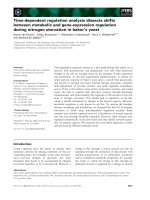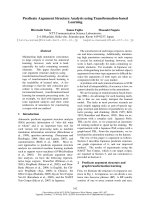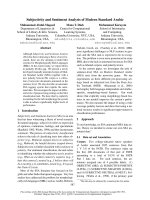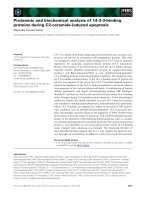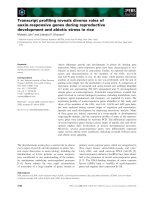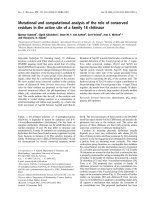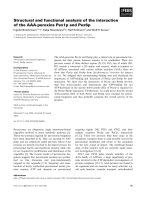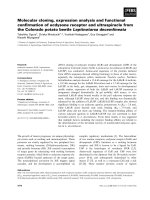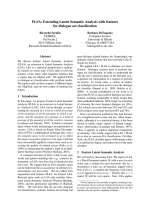Báo cáo khoa học: Transcriptome profiling analysis reveals multiple modulatory effects of Ginkgo biloba extract in the liver of rats on a high-fat diet pdf
Bạn đang xem bản rút gọn của tài liệu. Xem và tải ngay bản đầy đủ của tài liệu tại đây (349.38 KB, 9 trang )
Transcriptome profiling analysis reveals multiple
modulatory effects of Ginkgo biloba extract in the
liver of rats on a high-fat diet
Xiaomei Gu
1,
*, Zuoquan Xie
2,
*, Qi Wang
1,
*, Gang Liu
1
,YiQu
1
, Lu Zhang
1,2
, Jiahu Pan
3
, Guoping
Zhao
1,4
and Qinghua Zhang
1,2,4
1 National Engineering Center for Biochip at Shanghai, China
2 State Key Laboratory of Medical Genomics and Shanghai Institute of Hematology, Ruijin Hospital, Shanghai Jiaotong University School of
Medicine, China
3 School of Pharmacy, Fudan University, Shanghai, China
4 MOST-Shanghai Key Laboratory of Disease and Health Related Genomics, China
Ginkgo biloba has been used for medical purposes for
centuries in traditional Chinese medicine. The standard
extracts of G. biloba leaves [G. biloba extract (GBE)]
are now more widely used as dietary supplements or
phytomedicines in Western countries. Both experimen-
tal and clinical studies have demonstrated the cardio-
vascular, cerebrovascular and neuroprotective effects
of GBE [1–3]. Currently, the most common clinical
uses of GBE include vascular dementia, Alzheimer’s
disease, memory enhancement, intermittent claudica-
tion, Raynaud’s syndrome and tinnitus of vascular ori-
gin. The mixture of biologically active ingredients in
GBE accounts for the pleiotropic effects, including
antioxidant effects [4,5], inhibition of platelet aggrega-
tion and thromboxane B
2
production [6,7], vasodila-
tion [8,9] and modulation of cholesterol metabolism
[10,11]. The active ingredients of the mixture, such as
the flavonoids, have also been studied and have been
Keywords
Ginkgo biloba extract; high-fat diet; rat liver;
regulation; transcriptome
Correspondence
Q. Zhang, State Key Laboratory of Medical
Genomics and Shanghai Institute of
Hematology, Ruijin Hospital, Shanghai
Jiaotong University School of Medicine,
Shanghai 200025, China
Fax: +86 21 51320266
Tel: +86 21 51320288
E-mail:
*These authors contributed equally to this
work
(Received 8 September 2008, revised 29
December 2008, accepted 5 January 2009)
doi:10.1111/j.1742-4658.2009.06886.x
Leaf extract of Ginkgo biloba (GBE) is increasingly used as a herbal medi-
cine for the treatment of neurodegenerative, cardiovascular and cerebrovas-
cular diseases. Several studies have demonstrated many protective effects of
GBE in neurons, the endothelium and liver. In this study, we investigated
the molecular mechanisms underlying the effects of GBE in disorders
induced by long-term exposure to a high-fat diet (HFD). Rats were fed an
HFD with or without the GBE product GBE50 for 19 weeks. We found
that GBE50 reduced the development of fatty liver induced by an HFD
and inhibited the commonly observed elevation of serum cholesterol and
lactate dehydrogenase levels. Transcriptome profiling analysis showed that
several genes were modulated by GBE50 in liver, including those involved
in lipid metabolism, carbohydrate metabolism, vascular constriction, ion
transportation, neuronal systems and drug metabolism. Notably, a number
of genes coding for proteins involved in cholesterol metabolism were
repressed, and some were upregulated. Fatty acid biosynthesis appeared to
be repressed, whereas fatty acid metabolism appeared to be enhanced. In
conclusion, using transcriptome profiling analysis, we demonstrated the
molecular basis for the pleiotropic effects of GBE50, particularly those
involved in lipid metabolism. This study provided new clues for further
pharmacological study of GBEs.
Abbreviations
EST, expressed sequence tag; GBE, Ginkgo biloba leaf extract; HFD, high-fat diet; LDH, lactate dehydrogenase; PPAR, peroxisome
proliferator-activated receptor; SREBP, sterol regulatory element-binding protein.
1450 FEBS Journal 276 (2009) 1450–1458 ª 2009 The Authors Journal compilation ª 2009 FEBS
found to contribute to the antioxidant and ⁄ or free rad-
ical-scavenging properties, prevent stroke and transient
ischemic attack, and inhibit membrane lipid peroxida-
tion [12]. In addition, ginkgolide B has been shown to
be a potent platelet-activating factor antagonist [13].
A high-fat diet (HFD) is becoming an increasingly
common dietary risk factor for health problems in
modern society; such a diet contributes to the onset
and ⁄ or development of various cardiovascular and
cerebrovascular diseases, including hypertension, coro-
nary artery disease and vascular dementia. In animal
studies, an HFD has been found to elicit vascular dys-
function and cardiac perivascular fibrosis in rats prior
to the development of overt obesity, in the absence of
hyperlipidemia [14]. Alzheimer’s disease may have
developed as a result of an HFD, because amyloido-
genesis and tau hyperphosphorylation have been found
in cultured primary rat cortical neurons exposed to
saturated fatty acids [15,16]. In addition, hepatic stea-
tosis has been shown to develop in obese rats fed an
HFD [17].
Because GBE has been used in the treatment of vari-
ous cardiovascular and cerebrovascular diseases that
can be induced by an HFD, we propose that a combi-
nation of an HFD and GBE feeding may provide
insights into the molecular mechanisms of GBE action
in the treatment of these disorders. To test our pro-
posal, we used transcriptomic strategies, which are
now widely used in functional genomic research
because gene expression analysis has become necessary
to better understand the molecular mechanisms of her-
bal medicine [18–20]. To investigate the molecular
mechanisms underlying the pleiotropic protective
effects of GBE, we fed rats an HFD or an HFD plus
the GBE product GBE50 for 19 weeks. We then
removed the livers and subjected them to transcriptomic
profiling analysis using cDNA microarrays. Our results
have revealed multiple effects of GBE on rat liver as
well as the underlying molecular mechanisms mediat-
ing these effects.
Results and Discussion
Body weight and biochemical parameters
After 19 weeks of HFD (group H) or control diet
(standard chow; group C) exposure, there was no sig-
nificant difference in body weight between rats in the
two groups. However, rats fed the HFD plus GBE50
(group HG) showed a significant increase in body
weight. We also measured serum and hepatic total
cholesterol content as well as serum high-density lipo-
protein cholesterol content. We found that serum and
hepatic total cholesterol content were significantly
increased in group H over group C by 30% and 63%,
respectively. Furthermore, serum lactate dehydroge-
nase (LDH) increased three-fold in group H, reflecting
the harm caused by exposure to a long-term HFD.
The serum total cholesterol and LDH elevations found
in group H were inhibited in group HG, suggesting
that GBE50 prevented the harm caused by an HFD.
In addition, we found no significant alterations in the
levels of alanine aminotransferase, aspartate amino-
transferase or creatinine kinase in either group H or
group HG (Table 1). However, serum triglyceride
levels were slightly decreased in group H (24%) in
comparison with group C, although triglyceride levels
were not significantly different in group HG (14%).
No visible atherosclerotic plaques or vessel wall fatty
streaks were detected in either group H or group HG
(data not shown). Histological examination revealed
that the liver lipid accumulation in group H was inhib-
ited in group HG. Oil Red O staining of cryosectioned
liver tissues showed scattered and weak droplets in
Table 1. Body weight and serum biochemistry detection. HDL-c, high-density lipoprotein cholesterol; LDL-c, low-density lipoprotein choles-
terol; ALT, alanine aminotransferase; AST, aspartate aminotransferase; CK, creatinine kinase.
Group Group C (n = 4) Group H (n = 5) Group HG (n =4)
Final body weight (g) 330 ± 11 352 ± 40 395 ± 21
a
Serum total cholesterol (mmolÆL
)1
) 1.64 ± 0.08 2.04 ± 0.19
a
1.92 ± 0.04
a,c
HDL-c (mmolÆL
)1
) 1.05 ± 0.01 1.45 ± 0.18
a
1.28 ± 0.06
a
LDL-c (mmolÆL
)1
) 0.38 ± 0.07 0.42 ± 0.06 0.39 ± 0.04
Triglyceride (mmolÆL
)1
) 1.08 ± 0.17 0.82 ± 0.15
a
1.23 ± 0.24
ALT (UÆL
)1
) 120 ± 54 171 ± 132 134 ± 73
AST (UÆL
)1
) 187 ± 80 262 ± 96 181 ± 61
LDH (UÆL
)1
) 633 ± 513 2809 ± 1493
b
2106 ± 507
a,d
CK (UÆL
)1
) 2279 ± 1622 2723 ± 867 1813 ± 1602
Hepatic total cholesterol (mgÆg
)1
) 2.16 ± 0.17 3.54 ± 0.84
a
2.84 ± 0.25
a
a
P < 0.01,
b
P < 0.05, versus group C;
c
P < 0.01,
d
P < 0.05, versus group H.
X. Gu et al. GBE effects on rat liver gene expression
FEBS Journal 276 (2009) 1450–1458 ª 2009 The Authors Journal compilation ª 2009 FEBS 1451
group C, whereas group H had positively stained lipid
droplets that occupied a significantly greater area than
in group C (60%). However, lipid droplets in
group HG occupied a smaller area than in group H
(< 30%) (Fig. 1).
Global transcriptome modulation in rat liver with
an HFD and GBE50
Using strict criteria to remove unreliable data, includ-
ing weak signals, high expression levels or large vari-
ability in group C, 5008 genes ⁄ expressed sequence tags
(ESTs) were selected for later data analysis. The gene
expression information is available on the website
( and in
Table S1. The regulated genes were assigned to eight
groups according to the gene expression patterns in
group H and group HG (Fig. 2A). Among the total of
295 regulated genes ⁄ ESTs, 210 matched proper anno-
tations based on the UniGene database, whereas 85
matched ESTs only (Table S2). On the basis of ontol-
ogy annotations, the regulated genes were mainly those
involved in lipid metabolism, carbohydrate metabo-
lism, vascular constriction, ion transportation, neural
systems and drug metabolism. Regulation of lipid and
carbohydrate metabolism-related genes is discussed
below, and detailed information on the other regulated
genes is shown in Tables S1 and S2.
To verify the alterations in levels of the genes identi-
fied with microarray, eight lipid metabolism-associated
genes were selected for real-time RT-PCR validation.
As shown in Fig. 2B, the gene expression regulation
patterns found through RT-PCR were consistent with
data obtained through microarray, thereby demon-
strating the reliability of the microarray results.
Regulation of metabolism-related genes in
group H
In group H, 64 genes ⁄ ESTs were found to be upregulat-
ed and 22 genes ⁄ ESTs were found to be downregulated
in response to the HFD (Fig. S1 and Table S2). The
HFD affected carbohydrate metabolism, which could
result in insulin resistance and later development of dia-
betes [21]. Upregulation of Foxa3, which codes for a
transcription factor involved in glucose homeostasis by
binding to the proglucagon gene G2 promoter element,
and downregulation of an NADH-ubiquinone oxidore-
ductase member gene (CI-B9) and the pyruvate kinase
gene (Pklr), suggested impaired glucose metabolism in
group H rats. In addition, excess intake of dietary fat
caused deregulation of lipid metabolism. For example,
the upregulated genes for an acyl-CoA synthetase mem-
ber (Acsl1), pyruvate carboxylase (Pc), aspartoacylase 3
(Acy3) and solute carrier family 25 member 1 (Slc25a1)
are involved in lipid biosynthesis, and the downregulat-
ed genes for acetyl-CoA carboxylase beta (Acacb) and
fatty acid-binding proteins (Fabp1 and Fabp5) contrib-
ute to fatty acid metabolism. The repression of Hmgcr,
which encodes the cholesterol biosynthesis rate-limiting
enzyme HMG-CoA reductase, indicated that the endog-
enous cholesterol biosynthesis was impaired as a result
of the HFD. In addition, upregulation of the genes for
the cytochrome P450 family member sterol 12-a-hydro-
lase (Cyp8b1) and hydroxysteroid (17-b) dehydroge-
nase 2 (Hsd17b2) suggested augmentation of steroid
metabolism. Furthermore, the gene for sarcosine dehy-
drogenase (Sardh), a flavoenzyme involved in the oxida-
tive degradation of choline to glycine in rat [22], was
upregulated.
Transcriptome remodeling in group HG rat liver
In group HG, 243 genes ⁄ ESTs were found to be regu-
lated. Among the 22 genes ⁄ ESTs downregulated in
group H, 11 were similarly downregulated in
group HG, nine showed no significant difference from
group C, and two (Slc4a1 and Tubb2b) were upregulat-
ed as compared to group C. Of the 64 genes ⁄ ESTs
upregulated in group H, 19 genes showed similar
upregulation in group HG, 43 genes were not
significantly different from group C, and two genes
(Hsd17b2 and Trim28) were significantly downregulat-
ed. The other 107 downregulated and 102 upregulated
genes in group HG showed no significant upregulation
or downregulation in group H, indicating that these
genes were probably regulated by GBE50 in rat liver
(Fig. S1 and Table S2).
Fig. 1. Histology detection of rat liver. Oil
Red O-stained frozen sample sections of
livers from groups C, H and HG. Lipid
deposits in liver were revealed by Oil Red O
staining according to the method described
by Bouma et al. [34].
GBE effects on rat liver gene expression X. Gu et al.
1452 FEBS Journal 276 (2009) 1450–1458 ª 2009 The Authors Journal compilation ª 2009 FEBS
Lipid metabolism genes
By comparison with expression in group H, the further
repression of Hmgcr and the upregulation of Insig2,
the upstream negative regulator of Hmgcr, probably
contribute to impaired cholesterol biosynthesis.
Furthermore, decreased expression of gene for the bile
acid biosynthesis rate-limiting enzyme cholesterol 7-a-
hydroxylase (Cyp7a1) and Cyp8b1 indicates that the
conversion of cholesterol into bile acid may be
repressed, which is consistent with our finding of
upregulation of the gene for bile acid synthesis
A
B
a b c d
e
f
g
h
Fig. 2. (A) Box-plot presentation of gene expression regulation. Gene expression regulation was determined with the microarray data and
compared with reference samples from group C. Detailed information is provided in Experimental procedures. A cut-off of 1.5-fold was used
to identify regulated genes filtered with
SAM. Eight groups of regulation patterns were obtained, and the number of genes is indicated above
each graph. (B) Validation of eight genes with real-time RT-PCR.
X. Gu et al. GBE effects on rat liver gene expression
FEBS Journal 276 (2009) 1450–1458 ª 2009 The Authors Journal compilation ª 2009 FEBS 1453
negative regulator farnesoid X receptor (FXR or
Nr1h4) and downregulation of the gene for bile acid
biosynthesis circadian regulator Rev-ErbA alpha
(Nr1d1) [23,24]. Our finding of significant downregula-
tion of the gene for thyroid hormone-responsive pro-
tein (Thrsp) in group HG indicates an inhibition of the
lipogenic cascade in hepatocytes by GBE50 [25].
From our findings, we deduced that fatty acid bio-
synthesis was repressed and metabolism was enhanced
in animals exposed to an HFD with GBE50. Genes
involved in fatty acid biosynthesis, such as Acacb,
Acbd6 (acyl-CoA-binding domain containing 6), Scd2
(stearoyl-CoA desaturase 2) or associated genes,
Sorbs3 (sorbin and SH3 domain containing 3) and
Etnk1_predicted (ethanolamine kinase 1) were down-
regulated or repressed, as was Acsl1, which was upreg-
ulated in group H. The upregulation of the genes for
peroxisomal 2,4-dienoyl-CoA reductase (Decr2) and
glycerol kinase (Gyk) suggested enhanced glycerolipid
and fatty acid metabolism. The upregulation of
Cyp4a12 and downregulation of Fabp1 in both
group H and group HG indicated that GB50E had no
significant effect on these genes, whereas Fabp5 was
further repressed in group HG.
Carbohydrate metabolism and respiratory chain
genes
Downregulation of the genes encoding the glucose
transporter Glut2 ( Slc2a2) and glycogen synthesis-
associated enzyme UDP-glucose pyrophosphorylase 2
(Ugp2), glycogen synthase 2 (Gys2) and b4-galactosyl-
transferase (B4galt3) supported the hypothesis that gly-
cogenesis was impaired with GBE50 intake, although
Foxa3 remained upregulated in group HG. In addi-
tion, the decreased expression of Pc in group HG fur-
ther suggested impaired glyconeogenesis. Upregulation
of the insulin receptor substrate gene (Irs3) could con-
tribute to glucose homeostasis and utilization enhance-
ment in liver [26]. However, downregulation of
mitochondrial protein genes (CI-B9, Atp6v0e1 and
Nudfa8) indicates that the respiratory chain and oxida-
tive phosphorylation pathway was repressed in
group HG.
Regulation of cholesterol metabolism-related
gene expression by HFD and GBE50 in rat liver
To better understand cholesterol metabolism regula-
tion with the HFD and GBE50, real-time RT-PCR
was employed to validate the microarray data, includ-
ing genes that were not spotted or detected with the
microarray (Table 2). The nuclear steroid receptor
peroxisome proliferator-activated receptors (PPARs)
are transcription factors that form heterodimers with
retinoid X receptors to initiate the transcriptional regu-
lation of target genes. Three subtypes of PPARs (a,
b ⁄ d and c) and retinoid X receptors (a, b and c) have
been identified, and the PPARs are mainly regulators
of lipid metabolism [27]. In group H, genes for lipid
metabolism regulators (Ppard, Pparg
, and Rxra, Rxrb)
were upregulated in rat liver, suggesting that lipid
metabolism was activated. As the genes for low-density
lipoprotein receptor (Ldlr) and scavenger receptor
(Scarb1) are major members participating in choles-
terol uptake, the upregulation of Ldlr and Scarb1 sug-
gested enhanced uptake of cholesterol in liver of rats
in group H. Furthermore, downregulation of Hmgcr
suggested inhibition of endogenous cholesterol biosyn-
thesis with HFD intake.
In group HG, cholesterol metabolism genes were
regulated in the liver in concert. Specifically, decreased
expression of Ldlr and repression of Scarb1 suggested
that the uptake of cholesterol was reduced. The insulin-
induced gene Insig2 encodes an endoplasmic reticulum
protein that blocks the processing of sterol regulatory
element-binding proteins (SREBPs) by binding to
SREBP cleavage-activating protein, thus preventing the
latter from escorting SREBPs to the Golgi, and nega-
tively regulating sterogenesis. The increased expression
of Insig2 and the further repression of Hmgcr suggested
that endogenous cholesterol synthesis was repressed.
The upregulation of Nr1h4 and downregulation of
Cyp7a1 could contribute to bile acid biosynthesis
reduction. Meanwhile, the lipid metabolism regulators
were also modulated. Ppard showed significantly higher
expression in group HG than in group H, whereas
Pparg, Rxra and Rxrb were restricted to express at
normal level in group HG. Additionally, the upregu-
lated expression of the ATP-binding cassette super-
family members Abcg5 and Abcg8 in group H, which
form heterodimers and promote biliary cholesterol
excretion, was repressed in group HG, suggesting
that the cholesterol excretion from liver might also be
lessened by GBE50 (Table 2 and Fig. 3).
Experimental procedures
GBE
GBE50 is a standardized GBE product that matches the
standardized German product as EGb761. GBE50 is
approved by the China State Food and Drug Administra-
tion (SFDA) and is used clinically in China. GBE50 con-
tains > 44.0% total flavonoids, > 24.0% flavonoglycoside
and > 6.0% total terpen lactones. Ginkgolic acid is
GBE effects on rat liver gene expression X. Gu et al.
1454 FEBS Journal 276 (2009) 1450–1458 ª 2009 The Authors Journal compilation ª 2009 FEBS
controlled to be < 5 p.p.m. GBE50 products were kindly
provided by Shanghai Xingling Pharmaceutical (Shanghai,
China), manufactured under good manufacturing process
conditions (lot no. 20030608).
Animal diet and experiments
Thirty male Wistar rats (3 weeks old, weighing 50–55 g)
were obtained from Shanghai Laboratory Animal Center of
the Shanghai Institute of Biological Sciences, Chinese Acad-
emy of Sciences (Shanghai, China). Animals were housed in
a temperature-controlled room (23–25 °C) for 19 weeks
with a 12 h light ⁄ dark cycle, and allowed unrestricted
access to pellet food and water. The rats were randomly
divided into three groups of 10, including groups C, H and
HG. Group C was fed standard chow and acted as the nor-
mal control. Group H was fed an HFD, containing 8%
lard, 7% egg yolk powder, 0.5% sodium cholate and
84.5% standard rat chow. No pure cholesterol was added.
Group HG was fed the HFD supplemented with GBE50
(0.2%, w ⁄ w). The chows were manufactured and provided
by the Shanghai Laboratory Animal Center. One to two
animals in each group were killed for monitoring of cardio-
vascular and liver alterations at 8, 12 and 15 weeks follow-
ing initiation of the feeding paradigm. After 19 weeks,
Table 2. Expression of cholesterol metabolism-related genes. The mean expression level of each gene in group C rats was converted to
1.00 as reference. RT-PCR was conducted on three samples with triplicate experiments in each. Gapdh was used as an internal control.
Data for the microarray were derived from Table S3.
Category and gene
Group C Group H Group HG
Microarray RT-PCR Microarray RT-PCR Microarray RT-PCR
Uptake
Scarb1 1.00 ± 0.25 2.03 ± 0.40
a
1.44 ± 0.52
Ldlr 1.00 ± 0.06 2.19 ± 0.35
b
0.49 ± 0.08
b
Conversion
Acat1 1.00 ± 0.24 1.75 ± 0.26
a
1.31 ± 0.48
Biosynthesis
Insig2 1.00 ± 0.16 1.00 ± 0.08 1.25 ± 0.84 1.34 ± 0.14 1.81 ± 0.55
b
2.57 ± 0.45
b
Hmgcr 1.00 ± 0.26 1.00 ± 0.39 0.80 ± 0.18 0.49 ± 0.13
a
0.55 ± 0.14
a
0.36 ± 0.12
a
Secretion
Abcg5 1.00 ± 0.07 2.34 ± 0.20
b
1.55 ± 0.25
a
Abcg8 1.00 ± 0.02 1.76 ± 0.16
b
1.33 ± 0.03
b
Bile acid metabolism
Cyp7a1 1.00 ± 0.67 1.00 ± 0.51 0.65 ± 0.12 1.26 ± 0.04 0.16 ± 0.09
a
0.30 ± 0.00
a
Cyp8b1 1.00 ± 0.41 1.00 ± 0.20 1.30 ± 0.30 0.76 ± 0.27 0.68 ± 0.08 0.76 ± 0.57
Regulators
Nr1h4 1.00 ± 0.18 1.00 ± 0.47 0.96 ± 0.16 1.45 ± 0.74 1.41 ± 0.21 2.05 ± 0.52
a
Ppard 1.00 ± 0.06 2.58 ± 0.46
b
6.41 ± 1.62
b
Pparg 1.00 ± 0.01 2.08 ± 0.75
a
1.41 ± 0.33
Rxra 1.00 ± 0.19 3.07 ± 0.96
a
1.50 ± 0.49
Rxrb 1.00 ± 0.42 4.04 ± 1.35
a
1.67 ± 0.76
a
P < 0.05,
b
P < 0.01, versus group C.
Fig. 3. Ideogram illustration of regulated genes participating in cho-
lesterol metabolism network modulated by an HFD and ⁄ or GBE50
in rat liver. Genes are framed, the key substances are circled, tran-
scription factor genes are in ellipses, and the enzymes coded by
each gene are in oblongs. Regulation of the genes (> 1.5-fold) is
indicated by red (upregulation) and green (downregulation) in the
background, and yellow indicates no significant difference in regula-
tion from the control group. The left half represent regulation in
group H and the right in group HG. The red line with arrow indi-
cates positive regulation, the blocked green lines indicate negative
regulation, and the dashed lines indicate indirect inhibition. The
black lines indicate substance conversion or transportation flow.
The dashed lines indicate multistep conversion.
X. Gu et al. GBE effects on rat liver gene expression
FEBS Journal 276 (2009) 1450–1458 ª 2009 The Authors Journal compilation ª 2009 FEBS 1455
which marked the end of the experiment, all animals were
fasted overnight and decapitated in the morning. Livers
were removed and resected, and stored in liquid nitrogen
immediately for later mRNA analysis and cholesterol mea-
surement or stored in 10% formalin buffer (pH 7.3) for his-
topathological examination. Blood samples were clotted at
room temperature to collect sera for biochemical measure-
ments. All procedures were approved by Animal Experi-
ment Committee of the School of Pharmacy Fudan
University.
Biochemical measurement and cholesterol
detection
The collected sera were assayed with a Roche-Hitachi Mod-
ular P800 Chemistry analyzer and corresponding enzymatic
reagents (Roche Diagnostics, Indianapolis, IN, USA) in the
clinical laboratory of Zhongshan Hospital, affiliated to
Fudan University. Hepatic cholesterol content was deter-
mined as previously described [28], with a modification.
Briefly, frozen stored liver tissues were weighed and homog-
enized, lipids were extracted with isopropanol, and aliquots
were used for colorimetric determination of total choles-
terol using a cholesterol oxidase assay kit (Shanghai Jiemen
Biotech Co., Shanghai, China). Liver tissue cholesterol con-
tent was normalized to the liver tissue weight.
Histopathological detection
Liver tissues were fixed in 10% formalin, dehydrated and
paraffin embedded. A series of 5-lm-thick slices were sub-
jected to standard hematoxylin ⁄ eosin staining. For Oil
Red O staining, frozen liver tissues were embedded in opti-
cal coherence tomography and cryosectioned at 8 lm thick-
ness, following standard procedures. The histology slides
were cross-inspected by two pathologists.
RNA preparation and cDNA microarray
hybridization
Rat liver total RNA was isolated using the Trizol reagent
(Invitrogen) and purified with an RNAeasy column (Qia-
gen). RNA quality was assessed with a 2100 Bioanalyzer
(Agilent Technologies, Santa Clara, CA, USA). Homemade
cDNA microarrays containing 10 200 rat genes or ESTs
were fabricated as previously described [29–31]. The list of
the genes on the microarray is available on the website
and the
microarray platform was submitted to the GEO database
with the accession number GPL4294. Microarray experi-
ments were performed as previously described [29–31].
Equal amounts of RNA from four control rats were pooled
for use as a reference and labeled with Cy3-dUTP in later
experiments. RNA samples of 2 lg from group C (n = 4),
group H (n = 5) and group HG (n = 4) were individually
labeled with Cy5-dUTP. Hybridization was performed with
each individual sample and the common labeled reference
sample. After being washed, the microarray slides were
scanned with an Agilent microarray scanner.
Data analysis
Raw intensities of spots were extracted from images by
imagene v9.0 software, and the spots with a low signal-to-
noise ratio (< 2) were automatically denoted ‘flag > 0’.
Signal intensity normalization within each array was per-
formed by Lowess regression, and the signal ratio was
transformed to a log base 2 ratio. Further scale normaliza-
tion between arrays was implemented using the median
absolute deviation (MAD) approach. We successively
filtered out genes denoted ‘flag > 0’, which represented
more than 40% of the total number of arrays. We further
eliminated gene sets with unreliable expression measures,
on the basis of data from group C. Data were excluded if:
(a) the signal of log ratios in the control group was signifi-
cantly variable, as detected by a one-class comparison
(setting false discovery rate = 0.01) using the software
sam 2.20 [32]; (b) the standard deviation of the log ratios in
the control group was > 1; or (c) the absolute value of the
log ratio was > 0.585 (corresponding to a 1.5-fold change)
in at least two samples in the control group. On the basis
of the remaining dataset, we identified genes that were
upregulated or downregulated in group H and group HG
relative to control. This procedure was performed using a
one-class comparison procedure (setting false discovery
rate = 0.01) with sam software 2.20. In this analysis, we
tested whether the log ratio values of each treatment group
(H or HG) were significantly different from zero. The sig-
nificant genes identified by the independent groups were
used to perform hierarchical clustering of samples by using
cluster 3.0, and the results were visualized using treeview
(cluster and treeview were developed by Eisen et al.
[33]). The regulated genes were classified into different
groups on the basis of ontology, and the online database
KEGG () was applied in gene func-
tion pathway assignment.
RT-PCR analysis
Quantitative RT-PCR was conducted with an ABI
Prism7000 sequence detection system (Applied Biosystems,
Foster City, CA, USA) using SYBR Green I (TaKaRa Bio-
tech, Dalian, China). Genes for RT-PCR were selected on
the basis of the microarray data or because they were
known to be involved in lipid metabolism but were not
included in the gene list selected with microarray. The PCR
primer sequences are listed in Table S3. Reactions were
carried out in triplicate in a 25 lL volume for three animals
GBE effects on rat liver gene expression X. Gu et al.
1456 FEBS Journal 276 (2009) 1450–1458 ª 2009 The Authors Journal compilation ª 2009 FEBS
from each group. Following the PCR, the amplicon melting
curve was checked for PCR specificity.
Statistics
The number of rats from each group used in each experi-
ment is indicated in the figure legends. Values are presented
as mean ± standard error of the mean. A two-tailed stu-
dent’s t-test was used to calculate P-values, and a P-value
< 0.05 was considered to be significant.
Acknowledgements
The authors thank B. F. Zhang, J. Fang, Y. H. Yang,
S. J. Jiang, Z. D. Zhu, Y. Gao, L. B. Lin, Y. C. Chen,
F. He and G. R. Zhu for their technical assistance,
Q. Gao, G. A. Zhang, J. J. Xie and D. L. Xie for pro-
viding the GBE50 products, and J. S. Han, H. S. Xiao
and H. Y. Wang for their constructive comments and
discussions. This work was supported, in part, by
grants from the Chinese National High Tech Program
(863-2003AA2032), the Development Projects of
Shanghai Commission of Science and Technology
(03DZ19551, 05DZ19738, 06DZ19727) and the Rising
Star program of Shanghai (04QMX1476).
References
1 Mahady GB (2002) Ginkgo biloba for the prevention
and treatment of cardiovascular disease: a review of the
literature. J Cardiovasc Nurs 16, 21–32.
2 Yao P, Song F, Li K, Zhou S, Liu S, Sun X, Nussler
AK & Liu L (2007) Ginkgo biloba extract prevents
ethanol induced dyslipidemia. Am J Chin Med 35,
643–652.
3 Smith U (1994) Carbohydrates, fat, and insulin action.
Am J Clin Nutr 59, 686S–689S.
4 Chen JW, Chen YH, Lin FY, Chen YL & Lin SJ
(2003) Ginkgo biloba extract inhibits tumor necrosis fac-
tor-alpha-induced reactive oxygen species generation,
transcription factor activation, and cell adhesion mole-
cule expression in human aortic endothelial cells. Arte-
rioscler Thromb Vasc Biol 23, 1559–1566.
5 Smith JV & Luo Y (2003) Elevation of oxidative free
radicals in Alzheimer’s disease models can be attenuated
by Ginkgo biloba extract EGb 761. J Alzheimers Dis 5,
287–300.
6 Kudolo GB, Wang W, Barrientos J, Elrod R & Blodg-
ett J (2004) The ingestion of Ginkgo biloba extract
(EGb 761) inhibits arachidonic acid-mediated platelet
aggregation and thromboxane B2 production in healthy
volunteers. J Herb Pharmacother 4, 13–26.
7 Dutta-Roy AK, Gordon MJ, Kelly C, Hunter K, Cros-
bie L, Knight-Carpentar T & Williams BC (1999) Inhib-
itory effect of Ginkgo biloba extract on human platelet
aggregation. Platelets 10, 298–305.
8 Koltermann A, Hartkorn A, Koch E, Furst R, Vollmar
AM & Zahler S (2007) Ginkgo biloba extract EGb 761
increases endothelial nitric oxide production in vitro
and in vivo. Cell Mol Life Sci 64, 1715–1722.
9 Chen X, Salwinski S & Lee TJ (1997) Extracts of
Ginkgo biloba and ginsenosides exert cerebral vasorelax-
ation via a nitric oxide pathway. Clin Exp Pharmacol
Physiol 24, 958–959.
10 Lin SJ, Yang TH, Chen YH, Chen JW, Kwok CF, Shi-
ao MS & Chen YL (2002) Effects of Ginkgo biloba
extract on the proliferation of vascular smooth muscle
cells in vitro and on intimal thickening and interleukin-
1beta expression after balloon injury in cholesterol-fed
rabbits in vivo. J Cell Biochem 85, 572–582.
11 Yao ZX, Han Z, Drieu K & Papadopoulos V (2004)
Ginkgo biloba extract (Egb 761) inhibits beta-amyloid
production by lowering free cholesterol levels. J Nutr
Biochem 15, 749–756.
12 Maitra I, Marcocci L, Droy-Lefaix MT & Packer L
(1995) Peroxyl radical scavenging activity of Ginkgo
biloba extract EGb 761. Biochem Pharmacol 49,
1649–1655.
13 Cho HJ & Nam KS (2007) Inhibitory effect of ginkgo-
lide B on platelet aggregation in a cAMP- and cGMP-
dependent manner by activated MMP-9. J Biochem Mol
Biol 40
, 678–683.
14 Aubin MC, Lajoie C, Clement R, Gosselin H, Calder-
one A & Perrault LP (2008) Female rats fed a high
fat diet were associated with vascular dysfunction and
cardiac fibrosis in the absence of overt obesity and
hyperlipidemia: therapeutic potential of resveratrol
(trans-3,5,4¢-trihydroxystilbene). J Pharmacol Exp Ther
325, 961–968.
15 Patil S, Sheng L, Masserang A & Chan C (2006) Pal-
mitic acid-treated astrocytes induce BACE1 upregula-
tion and accumulation of C-terminal fragment of APP
in primary cortical neurons. Neurosci Lett 406, 55–59.
16 Patil S & Chan C (2005) Palmitic and stearic fatty acids
induce Alzheimer-like hyperphosphorylation of tau in
primary rat cortical neurons. Neurosci Lett 384, 288–
293.
17 Gauthier MS, Favier R & Lavoie JM (2006) Time
course of the development of non-alcoholic hepatic stea-
tosis in response to high-fat diet-induced obesity in rats.
Br J Nutr 95, 273–281.
18 Wang L, Zhou GB, Liu P, Song JH, Liang Y, Yan XJ,
Xu F, Wang BS, Mao JH, Shen ZX et al. (2008) Dis-
section of mechanisms of Chinese medicinal formula
Realgar-Indigo naturalis as an effective treatment for
promyelocytic leukemia. Proc Natl Acad Sci USA 105,
4826–4831.
19 Watanabe CM, Wolffram S, Ader P, Rimbach G,
Packer L, Maguire JJ, Schultz PG & Gohil K (2001)
X. Gu et al. GBE effects on rat liver gene expression
FEBS Journal 276 (2009) 1450–1458 ª 2009 The Authors Journal compilation ª 2009 FEBS 1457
The in vivo neuromodulatory effects of the herbal
medicine Ginkgo biloba. Proc Natl Acad Sci USA 98,
6577–6580.
20 Gohil K & Packer L (2002) Global gene expression
analysis identifies cell and tissue specific actions of
Ginkgo biloba extract, EGb 761. Cell Mol Biol 48, 625–
631.
21 Storlien LH, Pan DA, Kriketos AD & Baur LA (1993)
High fat diet-induced insulin resistance. Lessons and
implications from animal studies. Ann N Y Acad Sci
683, 82–90.
22 Bergeron F, Otto A, Blache P, Day R, Denoroy L,
Brandsch R & Bataille D (1998) Molecular cloning and
tissue distribution of rat sarcosine dehydrogenase. Eur J
Biochem 257, 556–561.
23 Noshiro M, Usui E, Kawamoto T, Kubo H, Fujimoto
K, Furukawa M, Honma S, Makishima M, Honma K
& Kato Y (2007) Multiple mechanisms regulate circa-
dian expression of the gene for cholesterol 7alpha-
hydroxylase (Cyp7a), a key enzyme in hepatic bile acid
biosynthesis. J Biol Rhythms 22, 299–311.
24 Duez H, van der Veen JN, Duhem C, Pourcet B, Tou-
vier T, Fontaine C, Derudas B, Bauge E, Havinga R,
Bloks VW et al. (2008) Regulation of bile acid synthesis
by the nuclear receptor Rev-erbalpha. Gastroenterology
135, 689–698.
25 Kinlaw WB, Church JL, Harmon J & Mariash CN
(1995) Direct evidence for a role of the ‘spot 14’ protein
in the regulation of lipid synthesis. J Biol Chem 270,
16615–16618.
26 Laustsen PG, Michael MD, Crute BE, Cohen SE, Ueki
K, Kulkarni RN, Keller SR, Lienhard GE & Kahn CR
(2002) Lipoatrophic diabetes in Irs1() ⁄ )) ⁄ Irs3() ⁄ ) )
double knockout mice. Genes Dev 16, 3213–3222.
27 Vidal H (2005) PPAR receptors: recent data. Ann Endo-
crinol (Paris) 66, 1S5–1S9.
28 Rodriguez-Sureda V & Peinado-Onsurbe J (2005) A
procedure for measuring triacylglyceride and cholesterol
content using a small amount of tissue. Anal Biochem
343, 277–282.
29 Li RY, Zhang QH, Liu Z, Qiao J, Zhao SX, Shao L,
Xiao HS, Chen JL, Chen MD & Song HD (2006) Effect
of short-term and long-term fasting on transcriptional
regulation of metabolic genes in rat tissues. Biochem
Biophys Res Commun 344, 562–570.
30 Zheng PZ, Wang KK, Zhang QY, Huang QH, Du YZ,
Zhang QH, Xiao DK, Shen SH, Imbeaud S, Eveno E
et al. (2005) Systems analysis of transcriptome and pro-
teome in retinoic acid ⁄ arsenic trioxide-induced cell dif-
ferentiation ⁄ apoptosis of promyelocytic leukemia. Proc
Natl Acad Sci USA 102, 7653–7658.
31 Du Y, Wang K, Fang H, Li J, Xiao D, Zheng P, Chen
Y, Fan H, Pan X, Zhao C et al. (2006) Coordination of
intrinsic, extrinsic, and endoplasmic reticulum-mediated
apoptosis by imatinib mesylate combined with arsenic
trioxide in chronic myeloid leukemia. Blood 107, 1582–
1590.
32 Tusher VG, Tibshirani R & Chu G (2001) Significance
analysis of microarrays applied to the ionizing radiation
response. Proc Natl Acad Sci USA 98, 5116–5121.
33 Eisen MB, Spellman PT, Brown PO & Botstein D
(1998) Cluster analysis and display of genome-wide
expression patterns. Proc Natl Acad Sci USA 95,
14863–14868.
34 Bouma ME, Amit N & Infante R (1979) Ultrastructural
localization of apo-b and apo-c binding to very low
density lipoproteins in rat liver. Virchows Arch B Cell
Path 30, 161–180.
Supporting information
The following supplementary material is available:
Doc. S1. Gene expression profile analysis.
Fig. S1. Functional categories of genes modulated by
an HFD and GBE50 in rat liver.
Table S1. Gene expression dataset of rat livers after fil-
tration.
Table S2. Genes regulated in group H and group HG.
Table S3. RT-PCR primer sequences.
Table S4. Expression levels of selected genes.
Table S5. Comparison of lipid metabolism gene
expression in group CG and group HG.
This supplementary material can be found in the
online version of this article.
Please note: Wiley-Blackwell is not responsible for
the content or functionality of any supplementary
materials supplied by the authors. Any queries (other
than missing material) should be directed to the corre-
sponding author for the article.
GBE effects on rat liver gene expression X. Gu et al.
1458 FEBS Journal 276 (2009) 1450–1458 ª 2009 The Authors Journal compilation ª 2009 FEBS
